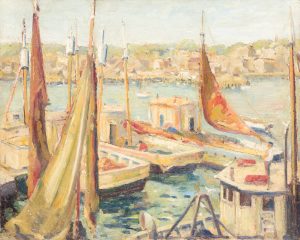Euphemia (E.) Charlton Fortune was an American Impressionist painter and illustrator known for ethereal landscapes set in California and Europe. As a woman artist working in male dominated art scenes in the Bay Area, Southern California, New York, and Europe, she chose to be known by the first initial of her first name in order to conceal her gender and avoid bias. Fortune was born in Marin County in 1885 but received her initial artistic training at St. John’s Wood School of Art in London after living with her aunt in Scotland while she was a teenager. She returned to the Bay Area in 1905, enrolling in the Mark Hopkins Institute of Art in San Francisco, which was led at the time by renown tonalist and co-founder of the Arts and Crafts Movement Arthur Mathews.
After the 1906 San Francisco earthquake destroyed Fortune’s home and paintings, in addition to the art school, she relocated to New York City, where she enrolled in the Art Students League for four years. During this time, she frequently traveled to the countryside upstate to paint local landscapes, including a sojourn at Lake George, where she worked alongside other budding artists such as Georgia O’Keeffe. In New York, she expanded her portfolio of magazine illustrations, contributing to publications like Harper’s Monthly Magazine, and was offered a position at Sunset Magazine, which she declined. Following a trip to Paris in 1910, she returned to Northern California, becoming a central figure in both the San Francisco and Monterey art scenes while briefly studying with William Merritt Chase, who was invited to the California Central Coast by local painters. In San Francisco, she regularly exhibited at galleries and institutions, gaining steady recognition from local critics. In the 1920s she traveled throughout Europe with her mother. Active during her time abroad, she was elected to the Society of Scottish Artists in 1922, and received a silver medal at the Paris Salon two years later.
Settling in Monterey upon her return to the U.S. in 1927, she became a prominent member of the Carmel Art Association and its affiliated school of California landscape painting. As an established painter, she exhibited at the Oakland Art Gallery and the Los Angeles Museum of History, Science, and Art, garnering positive reviews from critics in the Oakland Tribune, San Francisco Chronicle, and the Los Angeles Times. In 1931, Fortune gave up landscape painting for ecclesiastical design, contributing objects to churches throughout California.
- E. Charlton Fortune: The Colorful Spirit, a recent exhibition organized by the Pasadena Museum of California Art that traveled to the Crocker Art Museum, Sacramento and the Monterey Museum of Art renewed interest in the artist’s work as one of California’s foremost Impressionists and a pioneering woman artist.

